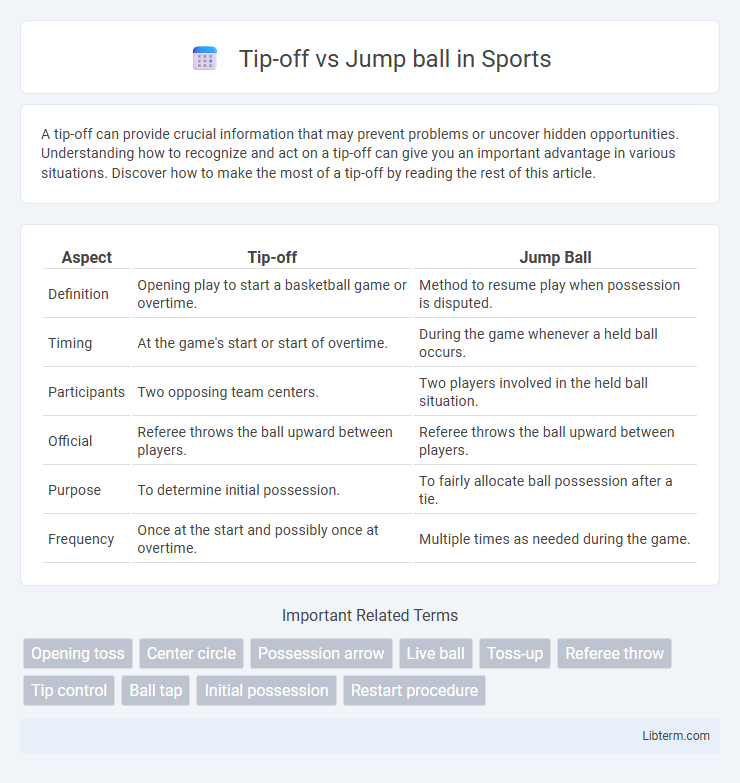A tip-off can provide crucial information that may prevent problems or uncover hidden opportunities. Understanding how to recognize and act on a tip-off can give you an important advantage in various situations. Discover how to make the most of a tip-off by reading the rest of this article.
Table of Comparison
| Aspect | Tip-off | Jump Ball |
|---|---|---|
| Definition | Opening play to start a basketball game or overtime. | Method to resume play when possession is disputed. |
| Timing | At the game's start or start of overtime. | During the game whenever a held ball occurs. |
| Participants | Two opposing team centers. | Two players involved in the held ball situation. |
| Official | Referee throws the ball upward between players. | Referee throws the ball upward between players. |
| Purpose | To determine initial possession. | To fairly allocate ball possession after a tie. |
| Frequency | Once at the start and possibly once at overtime. | Multiple times as needed during the game. |
Introduction to Tip-Off and Jump Ball
A Tip-off occurs at the start of a basketball game where the referee tosses the ball into the air between two opposing players who jump to gain possession. The Jump Ball situation arises during the game when two players from opposing teams simultaneously gain control of the ball, leading the referee to restart play by tossing the ball up between them. These methods ensure a fair contest for ball possession under regulated conditions governed by official basketball rules.
Defining Tip-Off in Basketball
Tip-off in basketball refers to the initial method of starting the game where the referee tosses the ball vertically between two opposing players who jump to gain possession. This action occurs at the center circle at the beginning of each game and any overtime periods. Unlike a jump ball, which can be called during the game to resolve possession disputes, the tip-off specifically initiates play.
What is a Jump Ball?
A jump ball is a method used to begin play in basketball where the referee throws the ball vertically between two opposing players who then jump to tap it to their teammates. This procedure typically occurs at the start of the game or overtime to determine initial possession. Unlike a tip-off that specifically applies to the game's start, jump balls can also be called during play when two players simultaneously gain possession.
Key Differences Between Tip-Off and Jump Ball
A tip-off occurs only at the start of a basketball game or overtime period, involving two opposing players contesting the ball as it's tossed by the referee. A jump ball can happen anytime during the game when players from opposing teams simultaneously gain possession, resulting in the referee tossing the ball between them to restart play. Unlike tip-offs restricted to initial game moments, jump balls serve as a fair method to resolve possession disputes throughout the match.
The Role of Tip-Off in Game Start
The tip-off initiates basketball games by allowing two opposing players to compete for possession as the referee tosses the ball into the air at center court. This method ensures a fair and neutral start, emphasizing the agility and timing of the jumpers involved. Unlike a jump ball, which can occur multiple times during a game to resolve possession disputes, the tip-off specifically marks the game's beginning.
Situations That Call for a Jump Ball
Situations that call for a jump ball include simultaneous possession disputes where two players grab the ball at the same time, such as after a held ball or a double foul. Jump balls also occur during the opening tip-off at the start of a basketball game or overtime period, establishing initial possession. Additionally, some leagues use jump balls to resolve certain out-of-bounds situations when teams contest possession equally.
Rules Governing Tip-Off vs Jump Ball
The rules governing tip-off and jump ball dictate that the tip-off occurs only at the start of the game or overtime, where the referee tosses the ball upward between two opponents attempting to gain possession by tapping it to a teammate. In contrast, a jump ball is used to restart play during the game when two players from opposing teams simultaneously gain possession, involving a similar airborne toss to contest possession. Both procedures follow strict regulations on positioning, no player entering the circle, and cannot be touched until the ball reaches its peak height, ensuring fair competition for initial control.
Strategic Importance of Winning the Tip-Off
Winning the tip-off at the start of a basketball game provides a crucial possession opportunity that can set the pace and momentum for the team. Securing the first offensive possession allows a team to implement their initial game strategy, potentially scoring early and applying psychological pressure on the opponent. Teams with strong centers and skilled jumpers often prioritize tip-off techniques to gain this strategic advantage and control early game dynamics.
Controversies and Common Misconceptions
Tip-off and jump ball often cause confusion due to their seemingly similar procedures, but their rules and contexts differ significantly, leading to controversies in NBA and NCAA games. A common misconception is that a tip-off always determines possession throughout the game, whereas tip-offs only occur at the start, with jump ball rules governing simultaneous possession situations during play. Controversies arise when referees inconsistently apply jump ball calls, often influenced by subjective judgment, sparking debates about fairness and the need for clearer standardized guidelines.
Conclusion: Tip-Off vs Jump Ball in Modern Basketball
Tip-off and jump ball in modern basketball serve as essential mechanisms to commence and regulate possession fairly. The tip-off initiates the game and overtime by allowing two players to contest the ball at center circle, while jump balls during gameplay resolve held ball situations without halting game flow excessively. NBA and FIBA rules have evolved to limit in-game jump balls, favoring alternating possession to enhance pace and maintain fairness.
Tip-off Infographic

 libterm.com
libterm.com